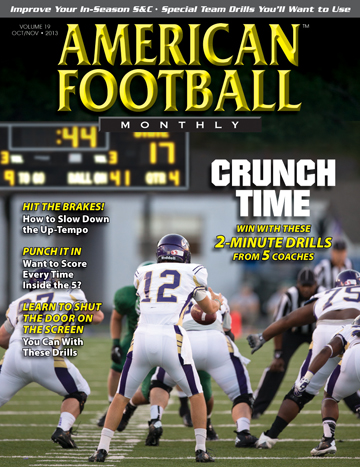Multiple Looks from a 3-4 Defense to Slow Down an Up-Tempo Offense
by: Joe WillisHead Coach Cedar Park High School (TX)©
More from this issue
When we played Lake Travis High School four years ago, Chad Morris – now the offensive coordinator at Clemson – was the head coach. That year we had a short week of preparation for his up-tempo, no-huddle offense.
After a relatively good start in the first quarter, our defense broke down after a turnover in the second quarter. Their fast-paced offense began to take its toll on our defense as we struggled to line-up before the snap, became confused with the offensive packages they were using and seemed to be in many mismatches.
The confusion was our undoing that night. Coach Morris and his staff taught me a valuable lesson about the mechanics of the game, the officials, and the nature of the up-tempo game. Everything we have done since then has been about how we practice, how we pursue the ball, how we communicate, how we view the playing field and its markings, and how we “Make it Rain.”
In order to slow down an up-tempo team, we call our defense like we call our offense. This includes marrying the front and coverage calls together and disguise pre-snap on every play. We practice this every day at game speed. You can’t practice slow and be ready for an up-tempo offense in one week.
I believe that outstanding offensive execution is about repetition, but great defensive play is really about recognition. On our first practice day of the week, we have a drill called “Set Rec” in which players have to make calls and ID offensive sets while in transition from a “cone of urgency” placed 20 yards away from the line of scrimmage. The cone is placed on the defensive side of the ball. If our tempo is slow, the cone is moved further away from the defense. If our tempo is good, it gets closer to the LOS.
Later in the week in team sessions, our players must run to the cone and then return to the offensive set to line up. This forces recognition and calls to occur under fatigue conditions. It also simulates the effect of multiple snaps in one drive. This also allows us to use one scout huddle that can practice quality looks. We use a second huddle for “whistle” plays and trick plays our opponent has used.
We also have a specific methodology of practicing the tempo defense. You need to practice a certain way with calls and checks from the sideline. You also need to develop good practice habits. Conditioning and communication can easily break down during a game. Getting your calls in while your defense is on the move and making sure your sideline signal is communicated is invaluable. Our defense is known as the “Black Rain” so we use the motivational phrase, “Make it Rain.”
We can check and change defensive fronts and coverages any time before the play starts. We then verify all changes with a highly visible sideline card. Communication is the key – not what scheme you have. We always have a base defensive call we refer to as “Alert.” In alert, we are personnel specific when setting our coverages. In our base call, deployment is the primary indicator for how we call our front and coverage.
We make a point of studying the offense to see what their game plan is. What kind of quarterback do they have – is he a dual threat? What is their base run play? Is it an inside zone or gap play? Where are all of the offensive eyes on each play? You also have to have a solid substitution strategy. You need to talk to the officials about your defensive substitutions before the game starts. Let them know if you plan to substitute when the offense does.
Here are some defensive principles when facing up-tempo opponents:
• Practice simulation.
• Less is more – build packages that week based on creating favorable matchups for your defense – that should be the goal.
• The front/coverage marriage is essential – tempo is designed to break down communication and create confusion.
• Our “alert” package is based on controlling their best offensive playmakers.
• What is their base tempo run and tempo pass play?
• Do they have a first and second down repeat tendency?
• Is their tempo a product of simplicity or can the QB change it.
• Study the pressbox QB (OC) and plan a disguise for him.
• Make the offense hesitate with pre-snap movement.
We use flash calls for our front and coverage described in one word. Our base call is how you line up against any opponent based on their offensive deployment. It is our best zone call with every player being an equal threat, and by design is a “Best Run Fit” defensive call. Here are some of our packages:
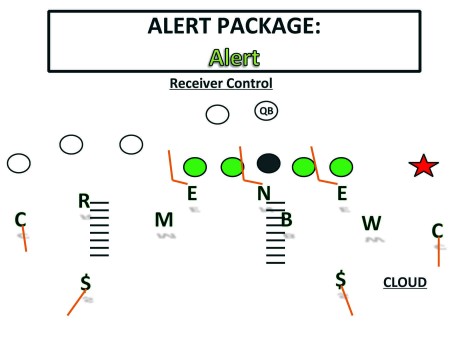
Alert Package (Diagram 1)
Alert is a zone-based call prioritizing your opponents’ personnel over their deployments. Our base call would prioritize coverages by deployment alone. We can tag the front to produce shaded alignments from the three down players. This is a game plan call so it adjusts week to week with consideration of “who and where” their best player will be. If he is in the backfield that week, the front would have a slant designed to control him and we would use different players to prevent one-on-one linebacker matchups.
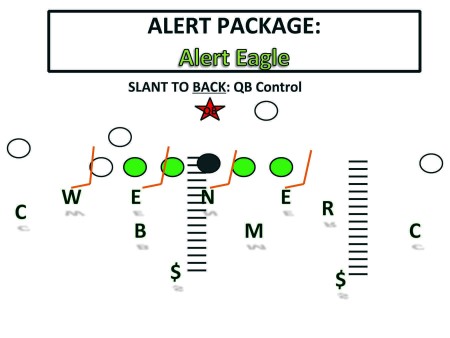
Alert Q (Diagram 2)
Alert Q is a slant tag used to produce reads in the read option looks and maintain LB “back fits” for the QB. This is a call we can tag with as “Base Q” or alert depending on who the next greatest threat is. Alert Q is a game plan call whereas Base Q is a week-to-week call.
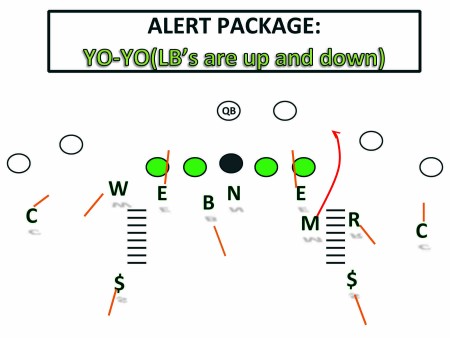
Alert Yo-Yo (Diagram 3)
Yo-Yo is a tag we use out of base and alert calls. If Alert Yo-Yo is called, consideration is given to a game breaker that is deployed. If Base Yo-Yo is called, we are basing the ILBs’ movements off of the RB and the protection scheme. Base Yo-Yo would be played with a zero nose and 4i. Alert Yo-Yo would allow the ILBs to slant the front with the call to certain looks. It’s a very simple way to bust man protection schemes and it plays out as a seven-man zone drop. It is also the number one way we engineer pocket control on a QB. In other words, if he can move to his left and throw, we will be moving him to his left as much as possible.
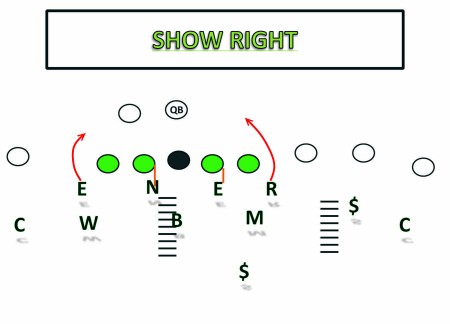
Show Right (Diagram 4)
Show right or left is a hash call with great cover down and also gives us an even front. It must be tagged with a direction, but it could be played anywhere on the field. It is really a cover 3, but when the opponent is on a hash mark – 75% of plays on the hash are up-tempo – you can tell your field corner that the top of the numbers on the field is the new sideline. There are a handful of QBs that can reach the far sideline from the pocket. Underneath routes by LBs in this call are critical.
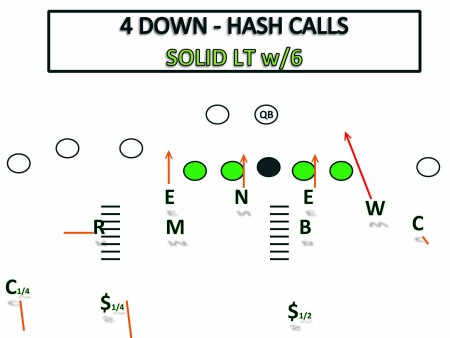
4-Down – Hash Calls : Solid LT w/6 (Diagram 5)
Solid is a zone call we use primarily on a hash. We change our front to a four-down look and use our boundary OLB in the pressure. You can also use “X stunt” to be the Whip or Weak linebacker on the call. It is quarter-halves coverage and if you get field trips, the Mike must help in coverage. The field corner and safety must also “lean in” to protect the middle of the field.
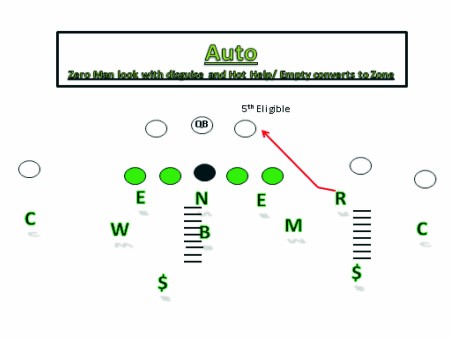
Auto (Diagram 6)
Auto is a zero man pressure that is designed to fit offensive formations. The four linebackers are responsible for the fifth eligible receiver and the QB. If the offense deploys an empty backfield or puts us in a bad matchup with the fifth eligible receiver, then we will convert to a middle-field closed coverage to prevent our linebackers being in man coverage vs. their game breaker. We may start this as four-man pressure and add on to QB movement, or we may go five with pressure with two linebackers. This is an easy call to match-up and works well with up-tempo teams.
The MLB always has the ability to convert this call to zone. Auto will also allow you to move the QB’s platform as well as provide second and third contain levels on an athletic QB. The diagram illustrates an outside linebacker blitz but we may also play “R” as “hot help” and down the blitz to the Mike. We may also bring the Whip LB late or hold him on the in-cut and fold.
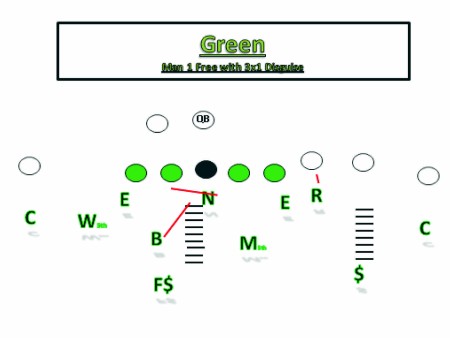
Green (Diagram 7)
Green or blue is our fast way of calling Man 1 free pressures. Blue tells the outside linebacker on the left that he is in coverage and green tells the outside linebacker on the right he is in coverage. We tie in an “x-game” with the nose guard and one of the inside linebackers. We always account for the fifth and sixth eligible receivers with the two remaining linebackers. There is a lot of carryover with zero man coverage, but we have dividers for the outside linebackers in coverage based on how the free safety will play. In 3 X 1 sets, we like to hold our disguise on the boundary hash and play him between the #1 and #3 receivers with eyes on the QB. It is possible to have an Auto Green call which holds your zone look vs. 3 X 1 coverages.
As a defensive coach, I believe the challenge of defending the up-tempo, no-huddle offense is here to stay. We believe you must rely on fundamentally sound technique in whatever you do. You must condition in mentally challenging situations daily. You must be both schematically sound and simple so that your players can experience “freedom” and not just be free to make mistakes in your scheme. We believe that communication is the number one breakdown created by the up-tempo offense and because of that, we have verbal calls, hand signals and sideline cards that all say the same thing to our players.
We have designed our defense to be multiple and fluid so that we are not predictable or checkable. We have the illusion of doing a lot when we are really simple. We have a plan for stopping our opponents’ QB and their best offensive player – the other four players will have to beat us. We will also tell the officials to stand over the ball when our opponent is substituting, because we sub 100% of the time in that situation. We will stem and move our fronts constantly so that the offensive line can’t identify our fronts. We will turn the game into what in our minds it was meant to be – are your 11 better than ours?
CONDITIONED TO WIN
Conditioning is critical for an up-tempo, no-huddle offense. But what about conditioning
for the defense to keep up with high-powered offenses? Joe Willis gives us his strategy.
What are the critical elements of conditioning your defense to be ready to play against an up-tempo, no-huddle offense?
Our coaching staff believes that practice pace must simulate game tempo. We try to build that into practice by moving our players around to the cone of urgency during our team session and creating 5-7 second drills during individual time that replicate the feel of the game. Our defensive practices are gauged on volume and productivity, and we believe this carries over in a game setting.
Are there times that must be maintained by your D-line, linebackers and defensive backs in practicing conditioning drills such as the 10, 20, and 40-yard sprints?
The only timed drill we ever perform during a practice is a “sudden change” drill. This is a “gasser- across the field x 2.” For stand-up players, it has a 32 second limit and for the D-Line it has a 35 second limit. There is a repeat over and back if the time is not made. It forces players to respond to negative, high pressure requirements. We believe this is proper mental conditioning as much as physical conditioning. Another drill our defensive coordinator, Michael Quintero, added that I believe helps that mindset is what we call the “perfect storm” drill. This is a tackle/turnover circuit that has a rapid pace and a quick rotation pattern.
How does your conditioning program vary during the off-season, at spring practice, and during the summer months?
At Cedar Park, we are going to make all phases of our off-season resemble up-tempo style of play. There is always a standard or time limitation to everything we do from bell to bell during our athletic period. There is a pay-up for not maintaining that standard. All of our condition and speed work starts with an emphasis on a “3 step burst” and a model of 5-10 second maximum exertion with no more than 30-45 seconds recovery time.
Our kids understand that they are responsible for cardio and extra strength work based on player goals, and they do a great job of meeting those expectations through work with trainers and team conditioning drills that captains’ lead off campus during the off-season. We also have an incredible commitment level to our summer strength and conditioning program that we offer during the summer months for our middle school and high school students. Our coaches and kids believe in this style of work. I also believe that our offense complements our defense by creating this mind-set during spring football that we are always going to play fast.
